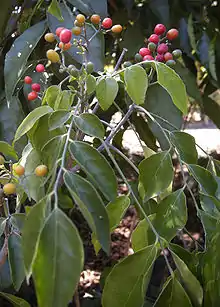Aurantioideae
Aurantioideae (sometimes known as Citroideae) is the subfamily within the rue and citrus family (Rutaceae) that contains the citrus. The subfamily's center of diversity is in the monsoon region of eastern Australasia, extending west through South Asia into Africa, and eastwards into Polynesia.[1]
| Aurantioideae | |
|---|---|
 | |
| Tabog (Swinglea glutinosa, Citreae) | |
| Scientific classification | |
| Kingdom: | Plantae |
| Clade: | Tracheophytes |
| Clade: | Angiosperms |
| Clade: | Eudicots |
| Clade: | Rosids |
| Order: | Sapindales |
| Family: | Rutaceae |
| Subfamily: | Aurantioideae Eaton |
| Tribes | |
| Synonyms | |
|
Citroideae | |
Notable members include citrus (genus Citrus), bael (Aegle marmelos), curd fruit (Limonia acidissima), species of genus Murraya such as curry tree (M. koenigii) and orange jessamine (M. paniculata), and the small genus Clausena.
Description and systematics
Aurantioideae are smallish trees or large shrubs, or rarely lianas. Their flowers are typically white and fragrant. Their fruit are very characteristic hesperidia, usually of rounded shape and colored in green, yellowish or orange hues.[1]
The subfamily can be divided into two tribes, the ancestral Clauseneae and the more advanced Citreae. Several genera have been recently reassigned from the latter to the former, but the arrangement of subtribes leaves much to be desired. The tribes, with subtribes listed in phylogenetic sequence and genera listed alphabetically, are:[1][2]
|
Tribe Citreae
|
Tribe Clauseneae
|
Footnotes
- Swingle, W. T. & Reece, P.C. (1967), The botany of Citrus and its wild relatives, University California Press, Los Angeles, CA., archived from the original on 2011-07-19
- de Araújo et al. (2003)
References
- de Araújo, E. Freitas; de Queiroz, L. Paganucci & Machado, M.A. (2003): What is Citrus? Taxonomic implications from a study of cp-DNA evolution in the tribe Citreae (Rutaceae subfamily Aurantioideae). Organisms Diversity & Evolution 3(1): 55-62. doi:10.1078/1439-6092-00058 (HTML abstract)
